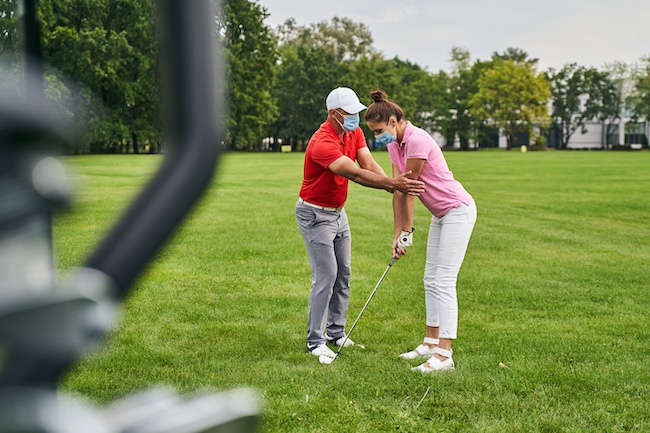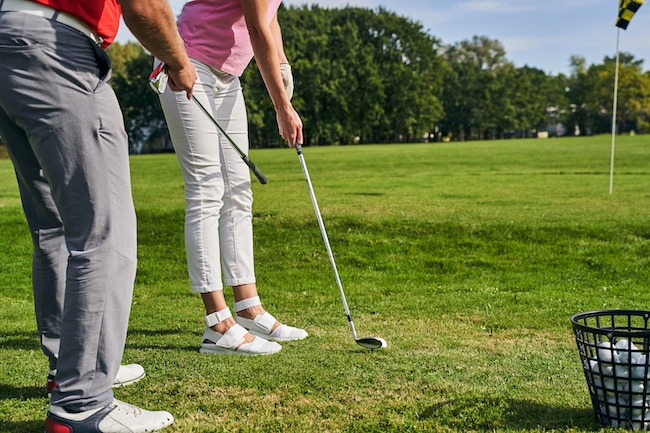There’s no correct or incorrect way to hit a golf ball. Stance is a major factor in your golf swing. It was one of the most basic things in a golf swing, yet it has unlimited importance. As the game evolved, many old-style instructions have gone out the window.
Let’s take a look at one variation of the golf swing, the open stance.
What is an open stance golf swing? An open stance in golf is when you set up to the ball with your feet pointing left of the target line, but your clubface is square or slightly open. Keep your weight on your left side and swing inside-out. This will help you hit a fade and prevent a slice. You can also generate more launch and power.
Most golfers don’t understand how using the wrong stance could hurt their game. Read the entire article to see if the open stance golf swing can help you take your game to the next level. You’ll also learn:
- The three types of stances in golf
- Pros and cons of the open stance
- Impact of the open stance
- When should you use an open stance?
- Common mistakes with an open stance
Let’s look at how stance impacts a golf swing and find out more about which stance to use in which situation.
Three Types of Stances in Golf

Your stance is the most important condition in your golf swing. A stance will define the path & speed of your golf club.
The more firmly you’re in contact with the ground, the more power you can create, but we’ll get into that later.
Let’s look at the three types of stances & their impacts.
- Open Stance
- Closed Stance
- Square Stance
An Open Stance
Pros
- Easier to hit fades
- More loft and launch
- Clears your hips faster
- Easier movement
- Great for bunkers and short game
- Helps with putting too
Cons
- Less distance than draws for inexperienced golfers
- Not ideal for windy days because you’re getting a higher loft
- Outside to inside swing path might not suit everyone naturally
What is an open stance swing in golf? In an open stance, you set up to the ball with your feet line pointing left of the target line. You get more space to swing the club through, but you have to deal with the tendency of the club to pull left post-impact.
An open stance assists in swinging the club more freely as it helps rotation.
One of the golf open stance benefits includes easier body movement. By starting at a more open position, your body has to do less to turn towards the target at impact.
Advanced players use a slightly open stance to hit a fadish ball flight. However, an open stance can also be a training aid for learning how to swing the club more in and out. As you set up open to the golf ball, you must exaggerate the in-to-out feel to swing the club right and exaggeration in practice balances golf course swings.
An open stance is also preferred on short shots. As you open your stance up, you have more room to swing the club freely and left, which keeps the clubface square on short shots.
Keep the following key things in mind when using the open stance.
- Always play for the fade if you use an open stance on the course. Your stance will help you assist your fade and will help you make curving the ball easier.
- An open stance will help you ease your transition into the golf swing. This makes making it comparatively easier to swing the club and use your lower body to hit shots.
- Hitting chips with an open stance is a more repeatable and consistent method for your short game. It promotes using your entire body to hit shots.
Read more: Draw vs Fade – A Complete Guide
A Closed Stance
When comparing open vs closed stance in golf, with a closed stance your feet line points right of a parallel target line.
It’s opposite to an open stance and assists in swinging the club right (more in-to-out). As you swing more in to out, you develop a more drawing ball flight.
A closed stance is dangerous in a golf swing.
Theoretically, it does help you swing right, but our body knows the club to move in a circle around the body. So the body likes to move left in transition, which could cause the club to move left, resulting in a steep swing and a pull shot.
Advanced golfers dread a shot going left more than a shot going right. In a closed stance, your body can overcompensate, making the ball go left or hook.
Pro Tip: Most amateurs with a closed stance stand too close to the ball. To avoid standing too close to the ball, pick a target and stand square to the ball. Then pick up your right foot & place it two inches back, perpendicular to your target line.
Here’s when you should use closed stance:
- A closed stance should be used when you aggressively curve the ball from left to right. You should manipulate your swing depending amount the amount of curve you want to put on it, usually around trees or something else.
- A slightly closed stance will help you hit better wedges as you will be inclined to hit more down into the golf ball.
- You can use a closed stance to hit a draw. But this will only work if you swing with a closed club face and an in-to-out club path.
If you’re interested more about the closed stance, Read our article, how to play with a closed stance.
Square Stance
A square stance represents your feet line and your target line exactly parallel.
A square stance is ideally supposed to promote a straight ball flight, but other prerequisites for a straight ball flight are a square clubface and a neutral path at impact.
A neutral stance is the most recommended for your standard golf shot. However, it’s not highly recommended for your short game (chipping and pitching).
Impact Of An Open Stance Golf Swing
An open stance affects the following factors of your golf shots:
- Swing Path
- Clubface
- Ball Position
- Ball Flight
- Distance
- Control
Swing Path
Swing path refers to how the club moves around your body in the golf swing. An open stance will affect the swing path in terms of impact.
An open stance will encourage the club to move more left at impact and a more out-to-in swing path. This swing path is ideal for hitting fades.
Beware, standing with an open stance can cause the club to come over the top or get cast out. Either of these traits is a golf swing killer.
Clubface
An open stance should theoretically cause the clubface to be open relative to the target line. However, there’s an exception to this rule. Each golfer is unique, and how a golfer moves the clubface through the golf swing varies from golfer to golfer.
A majorly closed clubface with an open stance is more penalizing than an open club face at impact. A major closed club face will make the ball go left, and if golf gods aren’t with you, it will hook too. Keep the clubface open or square when swinging with an open stance.
Ball Position
As you open up your stance, your entire body tends to tilt slightly to the left. If you open up your stance correctly, the ball will feel slightly behind you relative to a square stance. However, move the ball to the center of your stance to make a good swing with an open stance.
This might feel like the ball is slightly in front, but that’s not the case. That should be your open golf stance ball position. From there on, swing freely.
Consult our Golf Ball Position Chart to find out more about ball position and its importance.
Ball Flight
The out-to-in swing path will deliver side spin on the ball and move it from left to right in the air, A fade is a great shot in golf for many reasons, which I’ll talk about later.
An open stance also helps a higher ball flight. This higher ball flight can be useful in stopping the ball on the green, whether an iron or pitch shot.
Generally, a slice or cut is caused by the clubface held open at contact rather than square or slightly open to the swing path. A slice or cut is fixable for all golfers; it requires conscious effort to change your swing patterns.
Read this article on fixing a slice.
Distance
Since with a golf swing open stance position, there’s a higher possibility of a fade shot; you can expect the distance to drop a few yards than your standard straight shot with the same golf club.
The distance drops on a fade shot because the club face tends to be more open, adding more loft to the clubface, which causes less compression than a straight shot.
However, experienced golfers can create the ideal loft and spin in their fade shots to produce long-distance, piercing golf shots.
Control
Without ball control, nobody can ever be a good golfer. Ball control is hard to achieve in golf, and you can only achieve partial ball control as there will always be external factors influencing the ball flight, which you cannot account for.
However, with fades, you increase your chances of ball control and decrease your chances of a major mishit. This is due to several reasons.
- Spin rates are high in fade shots causing them to halt quickly, an essential skill for tougher conditions.
- A right-to-left ball flight is caused by a shallow swing which induces less spin in the golf ball—causing the ball to stay low and roll more.
- You can add spin to your wedge shots with a fade shot, causing them to rip back on the green.
- You can control the side spin on your fade shots more easily than on your draw-spinning shots. The main reason for this is a shallower swing when we’re hitting draws.
To improve your swing and hit more solid shots. Take a look at our best swing tips.
When Should You Use An Open Stance?

Opening the stance does not limit the golfer to hit, only a fade. Many golfers hit the ball with a draw from an open stance. It all depends on the clubface and swing path at impact. You learn to improve at the golf swing by experimenting with these elements to adjust ball flight and spin.
The out-to-in swing path is a natural tendency for some golfers. Some of the best golfers in the world hit a fade as their primary shot (John Rahm, Colin Morokawa, Dustin Johnson, etc.).
This proves that golf is about not knowing all the tricks but playing to your strengths.
Playing with an open stance has many advantages out on the course. It can induce control and confidence on the golf course.
Here are a few appropriate scenarios where an open stance is applicable:
Short Game
The basics of chipping in golf are aggressively focused on having an open stance for chips. An open stance assists the left-to-right movement of the club with a synchronized body movement.
Almost all professional golfers use an open stance for chipping and other shots around the green.
Opening your stance also helps you play a variable number of shots. You can control spin and trajectory, giving you more chances to save up and downs.
Bunkers & Flop Shots
In bunkers, always have an open stance with a firm base. This will help you use the bounce appropriately and keep the clubface open through impact. The same is also applicable to a cute, soft flop shot.
Be sure to hit slightly down on the golf ball with an open club face to maximize your results from these shots.
Fades
Fades are considered to be a more controlled shot than a draw. Theoretically, it’s because of how the clubface interacts with the golf ball at both impacts. Also, with how you set up for a fade, a mishit is less likely to cause as much damage as a hook or pull.
To hit a fade, most golfers use an open stance. Trying to hit a fade with an open stance can often result in an over-the-top and steep move.
To avoid this, good golfers, after opening their stance, make a few practice swings along the feet line. This gives them an out-to-in feel without getting steep.
Driver
Of the tee, especially with a driver. The fade has its pros and cons. However, it’s important to remember two things off the tee.
- Play to your strengths.
- And your primary goal is always to hit the fairway.
If you play a fade, aim for the left center of the fairway, open your stance to aim more left, and swing freely and confidently from there to hit a fade right down the middle.
Common Mistakes To Avoid In an Open Stance In Golf
Below are some of the common mistakes amateurs make in golf open stance:
- Never stand too close to the ball in an attempt to stand open to the golf ball.
- The ball position should not be back when you have an open stance. Try to readjust the ball where the club face feels comfortable behind the ball (middle or slightly in front)
- In an attempt to hit a fade with an open stance, most golfers come over the top and end up hitting behind the golf ball or pull it 40 yards left. This can be avoided by using a shallower swing that moves left post-impact.
- With an open stance, try to keep the arms in front of your body in the backswing. If the arms fall behind, you might get under the path causing hooks.
FAQ
Do Any Pros Play With an Open Stance?
Pros stand open to the golf ball when they want to hit a ball left to right. Although not all golfers are masters of the fade shot, some golfers go for the fade more often. Pro golfers with open stance include John Rahm, Dustin Johnson, Collin Morikawa, Ryan Fox, etc.
Is It Okay to Play Golf With an Open Stance
It’s completely alright to play golf with an open stance. All golfers are not gifted with excellent flexibility and muscle movement. So they have to compensate. If you’re somebody who has a problem opening his hips through impact. Try an open stance. It will make it easier to swing through the shot and turn the body easily.
Should Senior Golfers Use an Open Stance in Golf?
Senior golfers who want to use their body more at impact should use an open stance at address. An open stance will help senior golfers clear their hips and have more time and room to hit the golf ball.
Does Tiger Woods Putt With an Open Stance?
Tiger Woods does not putt with an open stance. However, when it comes to putting, your upper body moves around a line drawn on your spine. Sometimes golfers suffer from opening up the shoulders through the shot. Tiger has had yips with the same problem but managed to overcome it by feeling a more open stance at the address when putting.
Will an Open Stance Help a Slice?
An open stance won’t help a slice but make it worse. Try a closed stance or a square stance to fix a slice. However, the clubface is way more important than the stance when fixing a slice.
Which Shot Shape Is Better, a Fade or a Draw?
Neither is better than the other, and top players worldwide can execute either shape but will usually hit the one they are more comfortable with. Colin Morikawa and Dustin Johnson play most of their shots with a fade, while Rory McIlroy and Jason Day play draws. All can hit tremendous distances from the tee.
Can You Hit a Draw With an Open Stance?
Yes, you can hit a draw with an open stance. Use a strong grip, swing from the inside out, and follow through with your hips and shoulders. Aim slightly right of your target, keep your head down and your eyes on the ball, and relax and swing smoothly. With practice, you will be able to hit draws with confidence from an open stance.
Final Thoughts
An open stance golf swing is a type of stance that is used to hit a fade shot.
To hit an open stance golf swing, turn your feet to the left of the target line and square or slightly open the clubface. Keep your weight on your left side throughout the swing and swing from the inside out. Follow through with your hips and shoulders. Practice hitting open stance golf swings until you are comfortable with the feel. With practice, you will be able to hit fades and slices with confidence.
Open stance golf swings can help to prevent slices, hit the ball higher, and generate more power. However, they can also make it more difficult to hit a draw and hit the ball straight.
If you’re completely new to the game and want to improve your golf swing. Read our article on how to swing a golf club.
Read more:
- The Best Golf Tips To Improve Your Game
- How to Drive a Golf Ball Further
- How To Use Golf Alignment Sticks
Nick is the founder of GolfSpan and an avid golfer. He's not quite a pro but has over 15 years of experience playing and coaching golfers worldwide. His mission is to bring the golfing community a better experience when it comes to choosing the right golf gear and finding the right setup for your game.






